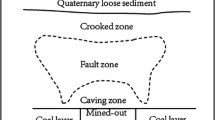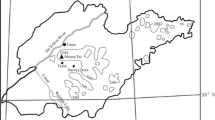Abstracts
The North China-type coalfield is the most important coalfield in China. With the development of Chinese economy, shallow coal resources (<600 m) have been exhausted and large-depth detection is being conducted. Water-inrush is disastrous for coal mining. However, large-depth (600–1200 m) detection of water-filled zones in the North China-type coalfield is a difficult geophysical task due to its low-resistivity coverage. The traditional loop-source transient electromagnetic method (TEM) cannot realize large-depth detection. On the other hand, high-resolution detection of LOTEM is limited by the problem of recording points and large volume effect. To explore the large-depth targets with high-resolution, Short-offset grounded TEM (SOTEM) was applied in the North China-type coalfield. SOTEM is one branch of grounded-wire TEM. The response of SOTEM is calculated using superposing-dipole method rather than the direct-dipole approximation, which is used in the calculation of the response of LOTEM. This paper analyzes the comparison of the resolution and detection depth between SOTEM and loop-source TEM at first. Compared to the loop-source TEM with frequently used parameters, the detection depth of SOTEM with the usual setup parameters is about twice of magnitude, and the resolution capability of SOTEM at large depth is higher than that of loop-source TEM. Then, the resolution capability and detection depth between LOTEM and SOTEM are analyzed. For the grounded-wire TEM, offsets are strictly related to the detection depth. So, the detection depth of LOTEM with larger receiver–transmitter offset will be greater. However, at the depth of 600–1200 m, the resolution capability to conductive targets of SOTEM is higher than that of LOTEM. At last, SOTEM with a 1000-m long source and 1000–2000 m offset is applied to the 1200 m-depth exploration of water-filled zones in the North China-type coalfield. The induced voltage is observed and transformed into magnetic field. Then, the data is inverted using the least mean fourth algorithm. The distribution of water on the top and bottom surface of the large-depth No. 4 coal seam is given, and is verified by the drilling result.















Similar content being viewed by others
References
Antonov YN, Manshtein AK (1979) Development of equipment for depth sounding with transient field in the near zone. Theory and fields in exploration geophysics. Akas Nauk SSSR, Novosibirsk, pp 18–26
Evan SU, David A, Jerry MH et al (2012) Numerical modelling analysis of short-offset electric-field measurements with a vertical electric dipole source in complex offshore environments. Geophysics 77(5):329–341
Geozalez JM (1979) Test of time-domain electromagnetic exploration for oil and gas. Colorado School of Mines, Colorado
Goldman MM, Grekova LB, Morozova GM et al (1976) Album of two-layer sounding curves for the transient horizontal magnetic field in the near zone. Akas. Nauk SSSR, Siberian Div 9
Goldman et al (2011) The 2D coastal effect on marine time domain electromagnetic measurements using broadside dBz/dt of an electrical transmitter dipole. Geophysics 72(2):101–109
Hordt A, Muller A (2000) Understanding LOTEM data from mountainous terrain. Geophysics 65(4):1113–1123
Hosseini K, Montazeri A, Alikhanian H, Kahaei MH (2008) New classes of LMS and LMF adaptive algorithms. Information and communication technologies: from theory to applications, ICTTA. 3 rd international conference on 05/2008
Li WY, Yan CW (2013) Bisection algorithm of central loop time domain transient electromagnetism all time apparent resistivity. J Kunm Univ Sci Technol (Natural science edition) 38(2):26–33
Menghini A et al (2010) TDEM method for hydrothermal water detection. First Break 28:93–101
Metwaly M, Elawadi E, Moustafa SR et al (2014) Groundwater contamination assessment in Al-Quwy’yia area of central Saudi Arabia using transient electromagnetic and 2D electrical resistivity tomography. Environ Earth Sci 71(2):827–835
Nestor HC, Alumbaugh D (2011) Near-source response of a resistive layer to a vertical or horizontal electric dipole excitation. Geophysics 76(6):353–371
Obukhov GG (1968) About some properties of the non-stationary electromagnetic fields in the Earth and their applications in electrical prospecting: Izvestia. Phys Earth 9:62–71
Rabinovich BI (1978) Comparative evaluation of sounding by transient fields in the far and near zones. Geol Geofiz 11:148–152
Spies BR (1989) Depth of investigation in electromagnetic sounding method. Geophysics 54:872–888
Strack KM, Luschen E, Kota AW (1990) Long-offset transient electromagnetic depth soundings applied to crustal studies in the black forest and Swabian Alps. Federal Republic of Germany. Geophysics 55(7):834–842
Ward SH, Hohmann GW (1991) Electromagnetic theory for geophysical exploration. In: Nabighian N (ed) Electromagnetic methods in applied geophysics. Society of Exploration Geophysics, Tusla, pp 121–223
Xue GQ, Li X (2012) Physical simulation and application of a new TEM configuration. Enviromen Earth Sci 67:1291–1298
Xue GQ, Bai CY, Yan S (2012) Deep sounding TEM investigation method based on a modified fixed central-loop system. J Appl Geophys 76(2012):23–32
Xue GQ, Zhou NN, Chen WY et al (2013a) Research on the application of a 3-m transmitter loop for TEM survey in mountainous areas. J Environ Eng Geophys 70(2013):2263–2270
Xue GQ, Cheng JL, Zhou NN et al (2013b) Detection and monitoring of water-filled voids using transient electromagnetic method: a case study in Shanxi China. Environ Earth Sci 70(5):2263–2270
Yan LJ, Su ZL, Hu JH et al (1997) Field trials of LOTEM in a very rugged area. Lead Edge 16(4):379–382
Zhdanov MS (2010) Electromagnetic geophysics: notes from the past and the road ahead. Geophysics 75(5):49–66
Zhou NN, Xue GQ (2014) The ratio apparent resistivity definition of rectangular-loop TEM. J Appl Geophys 103(2014):152–160
Ziolkowski (2010) Short-offset transient electromagnetic geophysical survey, US patent application publication, 0211367 AL Aug. 12
Acknowledgments
The authors would like to thank two reviewers and the editor for many helpful comments and suggestion. This work is supported by Chinese National Programs for Fundamental Research and Development (No. 2012CB416605), the National Natural Science Foundation of China (No. 41174090), and R&D of Key Instruments and Technologies for Deep Resources Prospecting (the National R&D Projects for Key Scientific Instruments), Grant No. ZDYZ2012-1-05.
Conflict of interest
The authors declare that they have no conflict of interest.
Author information
Authors and Affiliations
Corresponding author
Rights and permissions
About this article
Cite this article
Zhou, N., Xue, G., Chen, W. et al. Large-depth hydrogeological detection in the North China-type coalfield through short-offset grounded-wire TEM. Environ Earth Sci 74, 2393–2404 (2015). https://doi.org/10.1007/s12665-015-4240-y
Received:
Accepted:
Published:
Issue Date:
DOI: https://doi.org/10.1007/s12665-015-4240-y




